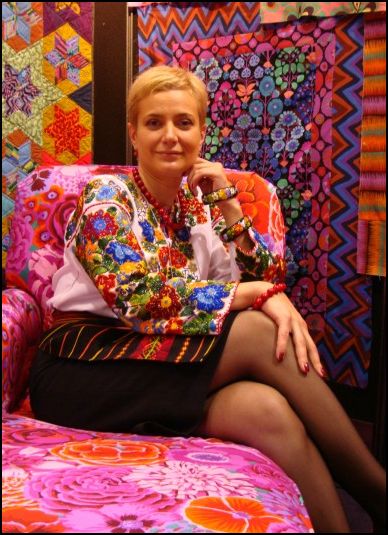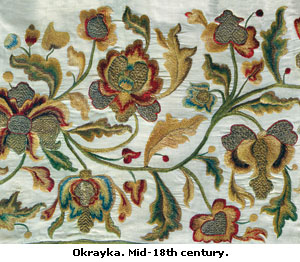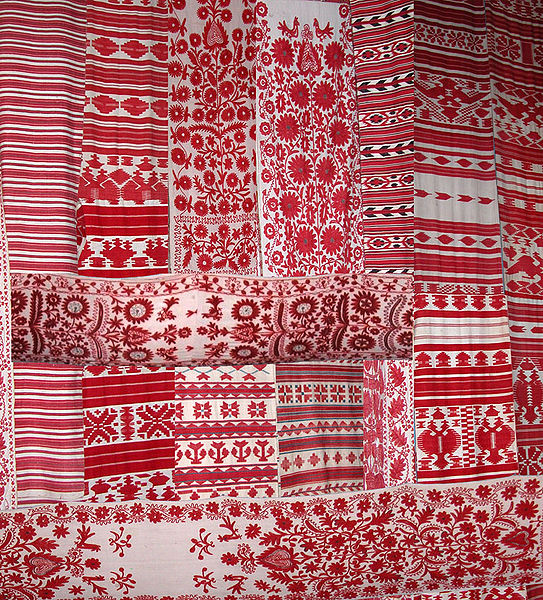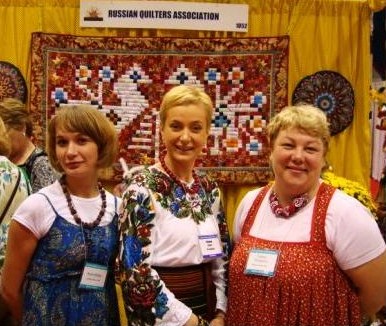This article was originally published in 2009.

Ukrainian Folk Arts Come Alive--Again
by Lilo Bowman
It isn't often that a person walking by the TQS booth at Quilt Fesitval will make us stop dead in our tracks. Usually we are preoccupied with the work at hand. But, when we saw the elegantly dressed Svitlana Dolesko, we just had to learn more about this Ukrainian beauty who almost single-handedly helped revive the folk arts of her beloved homeland. Svitlana was wearing a beautiful white linen blouse encrusted with hand sewn beaded flowers that ran the length of each sleeve and across the bodice. The blouse was certainly a stunner. We had to find out more. So we sat down over a cup of coffee to learn more about this incredible piece of hand work and soon discovered a much larger story.
Embroidery has a long history in the Ukraine that goes back over 2000 years. Beautiful stitch work was done primarily for men and women's wedding attire as well as the national costumes. But, this same stitching was also used to decorate numerous textiles in the home. Embroidery was produced primarily by women, with designs varying from region to region. Patterns generally feature flowers, however, geometric elements can also be found to be stitched using threads of cotton, silk, and even gold.
"In Ukraine, every locality has its favorite needlework stitches and its traditional use of color-altogether over a hundred main and auxiliary stitches. Needlework designs are very diverse: they are fitted to a definite patterns chosen to suit the size and shape of the article to be embroidered, in most cases-- a shape rectangular in form. Interest is focused above all upon embroidering women's and men's shirts ("sorochky"). In the latter, the often-narrow neckline collar and front placket are embroidered; in women's shirts, the main focus was usually on the richly embroidered sleeves." (Article by D.Dmytrykiw, Ukrainian Museum Archives)

It is customary for a young woman, once a proposal of marriage has been made, to begin stitching her wedding blouse. Svitlana explained that a young woman does not immediately say yes or no to the man. She states that she will begin working on her wedding blouse; a process that can often take as long as six months or more. If the woman does not want to marry the man, she may only work for one or two hours a day on the blouse; in hopes that the man will lose interest and another more desirable man will make a proposal. If however, the young woman is madly in love and wants to marry as soon as possible, she will invite her girlfriends over so that they can work together stitching the blouse.
Svitlana is lucky to have inherited the wedding blouses of her mother and both of her grandmothers, and plans to pass down this tradition to her daughters. Each blouse was made from linen hand woven by one of the grandmothers, so naturally there is a great deal of sentiment in each one. Not only was the fabric created by her grandmother, the stitching was done by a woman of the family. Naturally these are treasured family heirlooms.
It was during the years when Ukraine was part of the Soviet Union all traditional culture, folk art and language were forbidden. Over a period of fourty years these ancient cultural traditions were almost lost; only to be seen in museums. Svitlana's family had,however, in secret continued to carry on this embroidery work that was so important to them. In 2004 she realized that other young women did not have this piece of history to pass on. She felt compelled to do something about it.

Heavily embroidered decorative towels. Wikipedia.com
In 2005 Svitlana and a partner opened the Centre of Ukrainian Culture and Arts where women would be able come and learn traditional Ukraine embroidery. The idea was simple; everything would be provided (fabric, beads, thread,and instruction) at no cost to the students. They thought the women would come running. Svitlana advertised in the local paper, but after three months they still did not have a single student.
Not one to be easily dissuaded, Svitlana decided to proceed with a different plan. If the students didn't come to her, she would go out and find the students. She and four friends, dressed in her family's wedding attire, walked around the streets of Kiev carrying armloads of flowers. It also happened to be a national holiday, when many people were out walking and enjoying a day off from work and school. As each person came up to admire and compliment the ladies, they gave them a flower and told them about the school. By the end of the day they had given out all of the flowers.
One week later they began teaching their first fifty students. Since 2009 seven hundred women have made their own embroidered blouses, with more coming for classes every week. The school has since expanded to include other decorative folk arts including painting, ceramics, and quilting. It is no longer necessary to persuade women to attend the school.

In 2009 the Centre of Ukrainian Culture and Arts held its 2nd annual exhibition featuring the work produced by the students. Kiev is a city with many museums, so they made for the perfect exhibition spaces. Work that had been created from ancient times shared space with the work being created of today. Each museum featured a different element of the traditional Ukraine arts.
Eager to always bring in teachers with knowledge in the areas of decorative arts, the Centre was most excited when Jinny Beyer came as a guest lecturer and teacher in September of 2009. The event was covered by the media and was a huge success for the school which continues to add more and more classes each year.




.jpg)



I am surprised it is 10 years old.
How is this beautiful Svitlana doing? Is she having a lot of success with her embroidery?
My mom, God bless her, made everything. She was born in 1923, first child of some simple middle class people in Holland. She was born with only one hand, a left hand. She had two lovely arms and the strongest will. God decided she could do just fine with one hand. She lived to 93. She married my handsome daddy and they left the Netherlands for the US in 1947. She was on fire, she made clothing for her 4 kiddos, made snazzy bark cloth curtains for our house in Germany, and in France, and in the US she made her own snazzy dresses, she embroidered pretty things like Svitlana. Daddy got an assignment (St Dept) in Brussels Belgium, and mom learned to make lace. . I have so many of her treasures.
I love this story about Svitlana, I would love to meet her
I love quilts...pretty things...
RSS feed for comments to this post